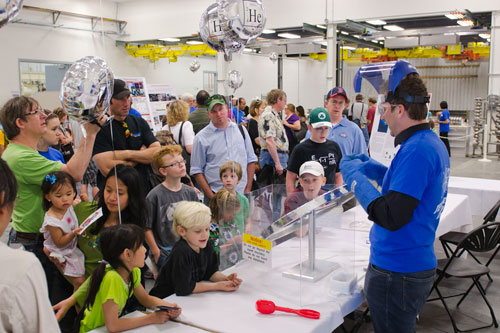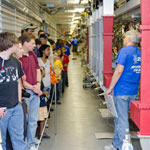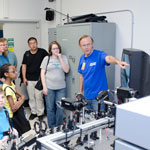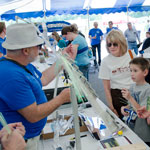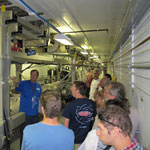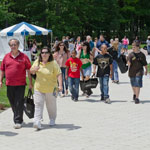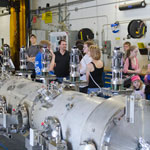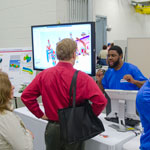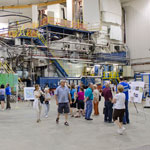
|
June 2012
|
|
|
The U.S. Department of Energy's Thomas Jefferson National Accelerator Facility
|
|
Staff Scientist Named DOE Early Career Award Recipient |
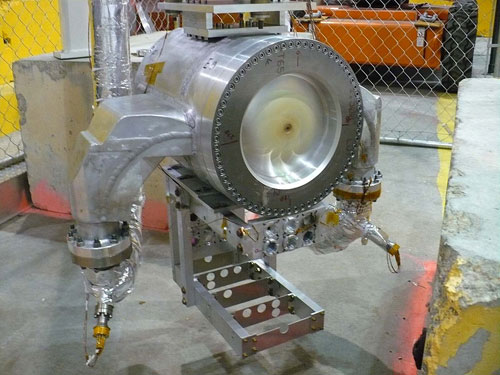 This photo is of the Q-weak experiment's target cell block that was used during the Q-weak Run I period. The target loop, which is almost two meters long and has a volume of 54 liters, runs vertically, on top of the target cell block. This system was designed using computational fluid dynamics (CFD).Staff Scientist Silviu Covrig was involved in designing, building and commissioning the 2500 W liquid hydrogen target for the Q-weak experiment that recently finished running in Hall C. Photo: Silviu Covrig, JLab
Born in the small Romanian town of Toplita, Jefferson Lab Staff Scientist Silviu Covrig has always been interested in the natural world and how things work. His innate talent and equal passion for physics shined through as early as 8th grade when his test scores, which were among the highest in his country, thrust him into a National Physics Olympiad. He was the first student from his city to do that. Throughout high school, he made it to the National Olympiads each year. In his senior year, he was one of 12 senior students who spent six weeks in the Romanian physics training camp that he describes as ''grueling,'' going through additional testing and exams. That early interest and experience has paid off handsomely. Covrig, now a staff scientist in Jefferson Lab's Experimental Hall C, has been selected for a Department of Energy Office of Science fiscal year 2012 Early Career Research Program award....... more |
|
|
2011 Thesis Prize Winner Explores Strange Matter
|
SRF Researcher Wins Student Award at IPAC 2012
|
Thousands Visited Jefferson Lab During Open House
|
||
|
|
||||
Below the Fold: |
||||
Staff Scientist Named DOE Early Career Award Recipient |
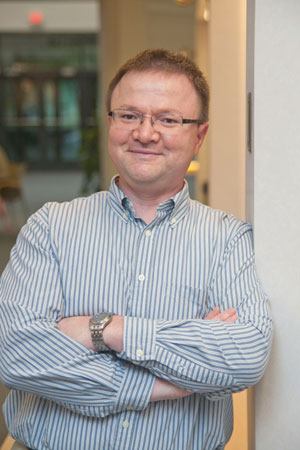 Staff Scientist Silviu Covrig has been selected for a Department of Energy Office of Science Early Career Research Program award. He plans to use the award to establish a research program at Jefferson Lab to improve the performance of liquid hydrogen targets, which are standard research tools at the lab. Born in the small Romanian town of Toplita, Jefferson Lab Staff Scientist Silviu Covrig has always been interested in the natural world and how things work. His innate talent and equal passion for physics shined through as early as 8th grade when his test scores, which were among the highest in his country, thrust him into a National Physics Olympiad. He was the first student from his city to do that. Throughout high school, he made it to the National Olympiads each year. In his senior year, he was one of 12 senior students who spent six weeks in the Romanian physics training camp that he describes as ''grueling,'' going through additional testing and exams. That early interest and experience has paid off handsomely. Covrig, now a staff scientist in Jefferson Lab's Experimental Hall C, has been selected for a Department of Energy Office of Science fiscal year 2012 Early Career Research Program award. The program, now in its third year, supports the development of individual research programs of outstanding scientists early in their careers and stimulates research careers in the disciplines supported by the DOE Office of Science. His award is valued at $500,000 each year for five years and will begin on July 1. He plans to use the award to establish a research program at Jefferson Lab to improve the performance of liquid hydrogen targets, which are standard research tools at the lab. "I was actually surprised to find that there is such a program as this," Covrig said of DOE's Early Career award. "I think this program, which is relatively new, is an excellent idea. It provides seed money to try to develop new technologies and push the boundaries of existing ones." Covrig graduated in 1995 with his undergraduate degree in Condensed Matter from the University of Bucharest and received his master's degree a year later from the same university. During that time, he worked as an undergraduate research assistant at the university and at the Institute for Opto-Electronics in Bucharest. He was accepted at Cal Tech for his graduate work and came to the United States for the first time in 1997. Pasadena, and Cal Tech's campus in particular, he recalled, seemed like a visual paradise, truly a botanical garden. "They really take care of their students at Cal Tech," he noted. "It's a very intensive school, but it was very enjoyable for me." While there he met the woman who would become his wife, Livia Marica. She was doing her residency in anesthesiology and is now a cardiac anesthesiologist with Virginia Anesthesiology and Perioperative Care Specialists (VAPCS). She works at Bon Secours Maryview Hospital in Portsmouth. The couple lives in northern Suffolk with their son, Alexander. During his time at Cal Tech, Covrig worked as a graduate research assistant, where he helped in building and commissioning the 1000 Watts (W) liquid hydrogen/deuterium target for the G-Zero (G0) experiment in the Jefferson Lab's Hall C. He was also a collaborator on two electron-scattering parity violation experiments, SAMPLE at MIT-Bates and G0 here. He received his Ph.D. in Experimental Nuclear Physics from Cal Tech. His thesis subject was the G0 experiment in forward angle mode; and his thesis advisor, Robert McKeown, is now Jefferson Lab's deputy director for science. After finishing his Ph.D. work at Cal Tech, it was off to chilly New Hampshire, where Covrig worked as a research scientist at the Center for Xenon Imaging. In collaboration with F. William Hersman, he developed technology for producing hyperpolarized 129Xe gas with the highest throughput in the world, and developed novel human lung imaging techniques based on magnetic resonance. Covrig came to Jefferson Lab in 2008 as a postdoc, where he was involved in designing, building and commissioning the 2500 W liquid hydrogen target for the Q-weak experiment in Hall C. The following year, he accepted a full-time position here. His Early Career Research proposal, titled "Computational Fluid Dynamics Facility to Support Targets for the 12 GeV Program at Jefferson Laboratory," seeks to establish a computational fluid dynamics (CFD) research program at the lab to investigate and standardize the performance of liquid hydrogen targets for nuclear physics experiments. The abstract reads: "Liquid hydrogen has long been a standard target material for fixed-target nuclear physics experiments at accelerator facilities worldwide. In the near future, experiments using very high intensity electron beams will require the removal of beam-deposited heating of up to an order of magnitude beyond that which has been achieved with previous targets. Through CFD simulations, it should be possible to reduce target boiling effects by more than an order of magnitude which will be crucial for the reduction of systematic errors in planned high beam intensity experiments. In this CFD research program, a range of experimental target designs will be simulated and optimized, including the 5000 W target envisioned for the ultra-high precision MOLLER (Measurement of a Lepto-Lepton Electroweak Reaction) experiment at TJNAF, which proposes a precision study of high-intensity polarized electron-electron scattering. This CFD research program will also analyze safety issues and will develop a standard procedure for operating liquid hydrogen targets in the safest manner feasible." "I am delighted that Silviu has been selected for this prestigious award. It is remarkable how he has built upon his work as a graduate student to design the Q-weak hydrogen target," McKeown said. "That target has demonstrated vastly improved performance over previous designs and was absolutely critical to the success of this experiment. Silviu's methodology also holds great promise for further improvements that are necessary for future experiments at Jefferson Lab and other facilities." To be eligible for an Early Career award, a researcher must be an untenured, tenure-track assistant professor at a U.S. academic institution, or a full-time employee at a DOE national lab, and the researcher must have received a Ph.D. within the past 10 years. The 68 selectees for fiscal year 2012 were chosen based on peer review of about 850 proposals. DOE provides these awards in six program areas: Advanced Scientific Computing Research (ASCR); Biological and Environmental Research (BER); Basic Energy Sciences (BES), Fusion Energy Sciences (FES); High Energy Physics (HEP), and Nuclear Physics (NP). Covrig's research was selected for funding by the Office of Nuclear Physics. Covrig is the fourth JLab-associated researcher to be selected for program funding. Xiaochao Zheng, an assistant professor at the University of Virginia, gained funding in the inaugural year of the program. In 2011, Jozef Dudek, who holds a joint JLab/Old Dominion University faculty position, and Pavel Evtushenko, a staff scientist at Jefferson Lab, each received an award. By Judi Tull |
2011 Thesis Prize Winner Explores Strange Matter |
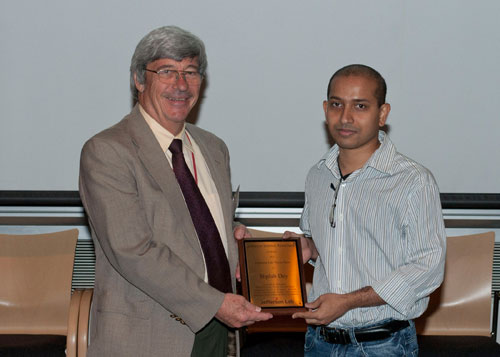 Biplab Dey, a postdoctoral fellow at the University of California, Riverside, won the 2011 JSA Thesis Prize. Jefferson Lab Director Hugh Montgomery presented the award to Dey on June 4, during the 2012 JLab Users Group annual workshop and meeting. Studying the strange side of nuclear physics has reaped Biplab Dey a rich reward: Dey was recently named the winner of the 2011 JSA Thesis Prize. The prize is awarded for the best Ph.D. student thesis on research related to Jefferson Lab science and includes $2,200 and a commemorative plaque. Dey received the prize at the Annual Users Group Meeting and Workshop held June 4-6 at Jefferson Lab. "We had 10 very impressive submissions, and the task of winnowing down to three finalists was not an easy one," said Sebastian Kuhn, chairman of the Board of Directors for the Jefferson Lab Users Group, the organization that represents scientists who conduct research at Jefferson Lab. "The final selection of the winner was then made by a special panel of senior scientists who unanimously agreed on Dey." Dey conducted his research with data from an experiment that took place in 2005 in Hall B as part of the g11 run period. "I actually joined the group after the data was taken, but I think it was an excellent analysis team and run group. It was a high-statistics run aimed at studying rare processes and many people contributed towards calibrating it carefully, which allowed me to focus on the physics aspects," Dey said. He performed analyses that focused on two rare particles – hyperons and phi mesons. Like protons and neutrons, these particles are made of quarks. But while protons and neutrons are built of up quarks and down quarks, the particles that Dey studied contain a type of quark that is rarely seen in ordinary matter. "Hyperons are almost like a proton, but with one up or down quark replaced by a strange quark. We really want to know what difference having a strange quark makes to the proton," Dey explained. "Then, the second reaction was a system that completely is only strange quarks. It's the phi meson, which has a strange quark and an anti-strange quark." Dey said studying these exotic particles gives us insight into the nature of the strong interaction, the force that glues quarks into matter, such as protons and neutrons. "I'm very grateful to my advisor, Curtis Meyer, and all the researchers and the people at JLab, including Hall B Leader Volker Burkert and Dave Ireland. I'm also thankful to my fellow students, Matt Bellis and Mike Williams. They really helped a lot," Dey said. "It feels good that people like what you have done and appreciate it." Dey, originally from Calcutta, India, received his bachelor's degree from the Indian Institute of Technology, Kanpur. His thesis was completed as part of his graduate work toward a Ph.D. at Carnegie Mellon University. It is titled "Differential cross section and polarization extractions for γρ → Κ+Σ0and γρ→ φρ using CLAS at Jefferson Lab, towards a partial wave analysis in search of missing baryon resonances." Dey is currently a postdoctoral fellow at the University of California, Riverside, where he continues to explore unusual combinations of quarks in B-mesons – particles that contain bottom quarks – at SLAC National Accelerator Laboratory. Four areas are considered in rating a submitted thesis: the quality of the written dissertation, the student's contribution to the research, the work's impact on the field of physics and service (how the work benefits Jefferson Lab or other experiments). The Thesis Prize was established in 1999 by the Southeastern Universities Research Association and is now one of many projects supported by the Jefferson Science Associates Initiatives Fund Program. JSA is the management and operations contractor for Jefferson Lab. The Initiatives Fund Program is funded by the JSA owners, SURA and CSC/ATG, to support efforts that further the scientific outreach and promote the science, education and technology missions of Jefferson Lab and the lab's user community. For more information about the JSA Initiatives Fund program, see: http://www.jsallc.org/IF/IFIndex.html. By Kandice Carter |
SRF Researcher Wins Student Award at IPAC 2012 |
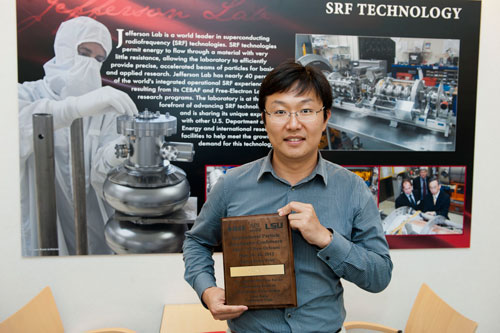 Chen Xu, a Ph.D. student with The College of William and Mary, is doing research at Jefferson Lab on superconducting radiofrequency cavity design and processing for future accelerators. His work received a Best Student Award at the 2012 International Particle Accelerator Conference, for his poster on the analysis of high field non-linear losses on SRF surfaces due to specific topographic roughness
It's no cliché to say that Chen Xu has science in his blood. His grandfather was an electrical engineer, his grandmother a cardiologist, his father is an irrigation scientist and his mother is a chemistry teacher. "Science," Xu noted in understatement, "'was a predetermined goal for me." Born in Beijing, this self-described "urban guy," graduated from Shanghai Fudan University third in his class with a degree in Materials Science in 2005. He then went on to Tsinghua University where he began work toward a Ph.D., with his thesis titled: Achieving High Energy Resolution Electron Energy Loss Spectrometer by Quadrupole and Sextupole Lattice. He also received a scholarship from the Korea Samsung Semiconductor Company to work as an intern/researcher at the company's hard-disk magnetic material testing center, and had the opportunity to travel throughout South Korea, Thailand, Hong Kong and Japan. After two years of graduate school, he knew it was time to make a change. In telling the story, he recalls a quote from the movie "Shawshank Redemption" to explain how he felt at the time: "some birds aren't meant to be caged. Their feathers are just too bright." He looked to the United States for his future and was accepted at numerous schools. He chose The College of William and Mary. When Michael Kelley, Free-Electron Laser Applied Research program manager and William & Mary professor, suggested that he come to Jefferson Lab to work on radiofrequency superconductivity (SRF) cavity design and processing for future accelerators, Xu jumped at the chance. "This was an opportunity for me to take experimental and theoretical practice and merge it with hands-on learning," Xu recalled. "Once I got involved in this, I really began to love this business. There are so many possible applications for this work that it's very, very exciting." His passion for the field was rewarded last when he received a Best Student Award at the 2012 International Particle Accelerator Conference, held May 20-25, in New Orleans for his poster on the analysis of high field non-linear losses on SRF surfaces due to specific topographic roughness. He's proud to note that he was the first SRF student to win the award. He received a plaque honoring the accomplishment and a cash award. Coming to the United States was a true culture shock. What he knew about the U.S. had come from movies and television. "I discovered that most of that is not real," Xu commented. "This is a very peaceful way of life here." And for someone who'd spent his early years in massive cities with skyscrapers, seeing birds and squirrels around his Newport News apartment makes it seem almost like a wilderness. He puts in long days, often not leaving the lab until 10 p.m., and loves the flexibility afforded him here. Committed to his science and personal success, Xu has a goal of publishing five papers before he's finished with his thesis; he's working on the fourth now. And he travels. Xu has made it his mission to see every state in the U.S. He's visited 40 of them so far – and in a recent four-day period spent time in Charlottesville, Va., and San Francisco – before returning for work on Monday. "I think of this traveling and learning as an investment in myself," he said. Local attractions that offer nature and solitude – think Maymont in Richmond, and Mariners Park in Newport News – lure him with their bucolic charms, perfect places to take a few books and spend quiet time reading as much accelerator science as he can. He has been an accomplished water colorist since childhood, and continues that pursuit when time permits. Xu thrives on the excitement of the JLab community. "People here are very self-motivated, and I think this is because of the flexibility that's offered here," he said. "We are doing cutting-edge science, and other colleagues are very helpful. My advisors are warm hearted and I've been given opportunities to visit other places such as Brookhaven National Lab, SLAC and even Germany." He praises his co-advisors, Michael Kelley and Charlie Reece, the SRF Institute's Process and Materials group leader, for their expert guidance, and was excited by the encouragement he received for his IPAC poster from Andrew Hutton, the Accelerator Division's associate director. Winning the IPAC award was both an acknowledgement of his hard work, he said, and an opportunity to share the work going on at the lab. He was eager to take part of his 10-minute presentation at IPAC to also let the 1,500 attendees know that he expects to finish his thesis at the end of this year and will be looking for a postdoc position. "This gave me a chance to become known and, hopefully, it will help open career doors for me," he concluded. By Judi Tull |
Scientists Spun Up Over Neutron Result: Tricky Spin Experiment Yields Evidence of New Quark Behavior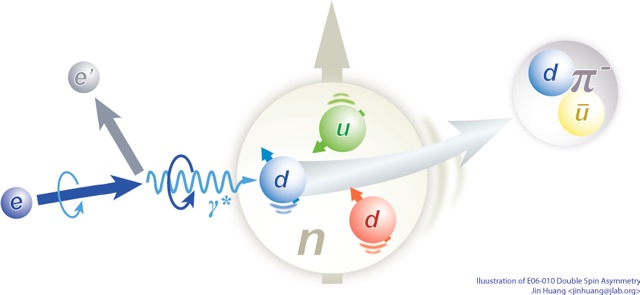 A new measurement on spinning neutrons conducted at Jefferson Lab provides the first indication of a new type of behavior of moving quarks inside the neutron. The measurement indicated a partial alignment of quark spin perpendicular to the neutron's direction of spin. This phenomenon can be pictured as a group of passengers lying down sideways on a Merry-Go-Round as it spins. This transversal helicity can only be observed if the quarks are moving orbitally inside the neutron. The result was recently published in Physical Review Letters. Quark orbital motion has long been suspected to be present in neutrons as well as in protons, which together make up 99 percent of the mass of the visible universe. In simple terms, quark orbital motion can be thought of as movement, such as the swirling movement of a spinning top as it meanders across a flat surface. Jin Huang is a postdoctoral associate at Los Alamos National Laboratory and the lead author on the scientific paper. The paper was based on the research he performed for his Ph.D. thesis at Massachusetts Institute of Technology. He says the difficult measurement was made possible by an advanced target. "Jefferson Lab has this unique facility with a high-energy polarized electron beam and a state-of-the-art polarized helium-3 target, and this target is an indispensable instrument for our measurement," he says. The target is a mix of old-world craftsmanship and cutting-edge precision. The vessel that holds the rare helium-3 gas is crafted of hand-blown glass. Surrounding the glass target is a network of lasers, magnets and other devices that comprise the target system. The target system polarizes, or sets the nuclei of the helium-3 spinning in a preferred direction, and flips that polarization to the opposite direction every 20 minutes. What makes helium-3 an excellent target for accessing the neutron is its makeup. The nuclei inside helium-3 contain one neutron and two protons. Set the nucleus spinning, and the two protons adopt opposite spins, mostly canceling each other out (spinwise). That leaves the sole neutron spinning in the same direction as the entire helium-3 nucleus. "The target provides a transverse polarized neutron – a neutron which is polarized perpendicular to the direction of the electron beam," Huang explains. Huang and his colleagues bombarded the neutrons with polarized electrons from JLab's Continuous Electron Beam Accelerator. The high-energy electrons penetrated deep inside the neutron, striking one of its quarks. Precision detector systems observed the departing electrons, as well as the remnants of the struck quarks as sub-atomic particles, such as negative pions (composed of an anti-up quark and a down quark). The experimenters counted these negative pions as they flipped the polarization of the neutrons and of the beam electrons. Slightly different numbers of the negative pions were seen when the neutron's spin direction was flipped from up to down, demonstrating a behavior of the quark's transversal helicity, i.e. quarks have arranged their spin partially in the sideways direction. "We found indications that within the spinning neutron, the quark has the probability to have its spin aligned sideways. That's a new type of behavior for quarks moving inside the neutron, which was unveiled by evidence from our measurement for the first time," Huang says. "The quarks must not just sit in the middle of the neutron, they must be moving around in some kind of angular motion. In simple words, we found that the quarks are milling around in a circle while some of them are pointing their heads sideways" explains Xiaodong Jiang, a staff scientist at Los Alamos National Laboratory and co-spokesperson for the experiment. The success of this and other recent experiments has inspired a rich program of future experiments to further explore transversal helicity in the neutron with much higher precision and larger kinematic coverage at Jefferson Lab following the upgrade of its CEBAF accelerator to 12 GeV. The experiment was performed in Jefferson Lab's Hall A in the fall of 2008. More than 110 scientists from more than 35 institutions and 10 countries collaborated to perform the experiment, which was supported by the Department of Energy and the National Science Foundation. The paper for this experiment is posted at: Users Group Announces Poster Contest WinnersThree young scientists were recognized at the end of the 2012 Users Group Poster Competition held in conjunction with the Jefferson Lab Annual Users Group Meeting and Workshop in early June. When the results were in, it was a tie for first place: Zachary Brown, from The College of William and Mary, and Erin Seder, University of Connecticut, each received a prize of $750. Don Jones, University of Virginia, received third place and a prize of $250. Twenty-three abstracts were submitted for the 2012 Users Group Poster Competition. The posters were judged on the quality of the poster, the presenter's command of the subject matter, and the overall impression of the poster and the presentation. Judges for this year's poster contest were Robert Michaels, JLab; Alexandre Deur, JLab; Steve Wood, JLab and Carl Carlson, The College of W&M. 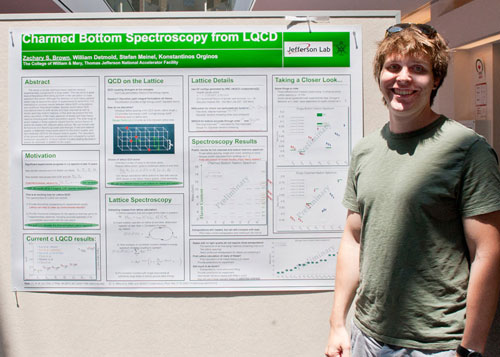
Zachary Brown, The College of William and Mary: Charmed Bottom Spectroscopy from LQCD
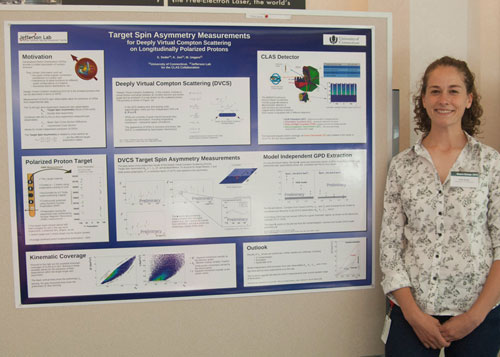 Erin Seder, University of Connecticut: Target Spin Asymmetry Measurements for Deeply Virtual Compton Scatter on Longitudinally Polarized Protons
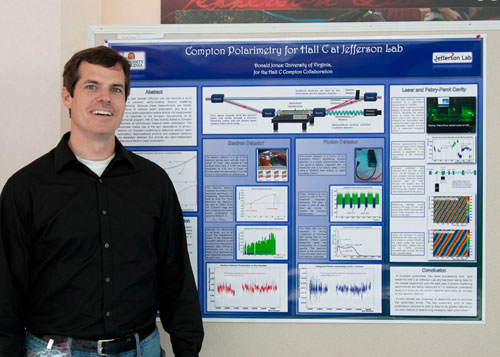 Donald Jones, University of Virginia: Compton Polarimetry for Hall C at Jefferson Lab
Safety Warden Puts Tornado Training to Work After Hours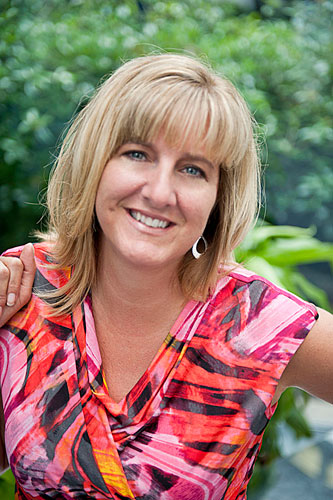 Rachel Harris, administrative support for the Physics Division, serves as the Safety Warden for CEBAF Center's F Wing. She recently used her tornado preparedness and response training when confronted with a tornado in Hampton, Va.
When Rachel Harris heard the sirens sounding at Langley Air Force Base on the evening of June 1, she knew what they were and what they meant: tornado. That evening at the Betty Smith School of Dance on North King Street, Harris was one of three adults and 21 youngsters who were rehearsing for an upcoming performance at Kecoughtan High School, when a tornado packing 98 mile-an-hour winds tore through downtown Hampton. Harris, who has worked at Jefferson Lab for 17 years in administrative support for the Physics Division, has also served as the Safety Warden for CEBAF Center's F Wing for the last 16 months. In that role, she's been through two tornado drills as the lab has ramped up its tornado preparedness. And because of that training, she knew just what to do. "Right away, I took charge," Harris recounted. "The children were starting to panic and the other adults had no idea what to do." She was immediately aware that the front of the building was all glass and that moving everyone to a different room was paramount. Cell phones were ringing and buzzing, signaling incoming phone calls and texts to many of the children, whose sense of alarm rose as the word "tornado" flashed on their screens. Just as she had learned in her safety training at the lab, she shepherded her charges into an interior room and closed all the doors. To distract the children, she kept the music going. "I felt bad for the little kids," she said. "They were really scared." Then, after the tornado had passed she had the dancers contact their parents and let them know they were alright. The tornado began as a waterspout around the Monitor-Merrimac Bridge Tunnel and tracked over Chesapeake Avenue. It trashed the Hampton Yacht Club, brought down electrical lines and trees and caused some damage before moving into the Chesapeake Bay. It passed within about a mile and half from Harris' location. She could hear its roar in the distance. This was not her first close encounter with a tornado. In 1994, Harris was working at a Hampton bank when a tornado came through on Hardy Cash Road. She and the other employees took cover in the bank's walk-in safe as it passed nearby. "It really does sound like a train," she recalled. And she's often visited her brother who lives in tornado-plagued Alabama. "There, the sirens not only sound but announcements are made about the tornado's current location and oncoming path," she noted. "Rachel is to be commended for her clear and quick thinking," said Mary Logue, ESH&Q Division associate director. "It is gratifying to see that our employees take their training seriously, and that they take that knowledge and their sense of responsibility beyond the work place, as Rachel did. She assessed the situation, took charge of the group and led them to safety, and followed through with accountability afterward." Logue noted, "Taking and internalizing safety training and participating in drills and exercises to rehearse appropriate response actions keep us safer at work and in general in life. We never know when the training and preparation could be put to use; but we do know that having the training and the knowledge can save lives and reduce injuries." In her position as a safety warden, Harris is the safety ''eyes and ears'' for the Physics Division every day – for emergency management actions like tornado response as well as scheduled activities like safety walk-throughs and fire extinguisher checks. Harris pointed out, "We do regular safety walk-throughs and take steps to correct any problems we might see." "It's a high priority for us to keep the workplace safe," said Bert Manzlak, the Environmental, Health & Safety Division liaison to the Physics Division. "Our safety wardens are on the front line of that effort. Rachel has the responsibility and she gets the support she needs to continue doing this important work." By Judi Tull Editor's note: Information about JLab's Emergency Management program may be found at: https://www.jlab.org/emergency-information More information about tornadoes and tornado preparedness is available on the NOAA web site at: http://www.nssl.noaa.gov/edu/safety/tornadoguide.html, and on the Virginia Department of Emergency Management web site: http://www.vaemergency.gov/readyvirginia Eastport Customs Brokers Win Small Business Award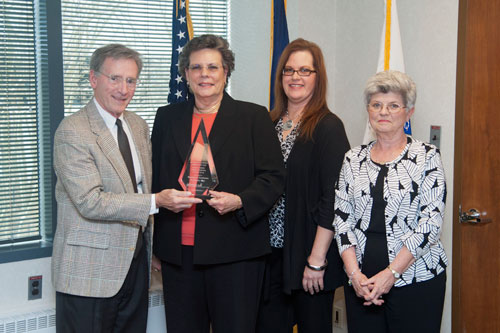 Jefferson Lab Chief Operating Officer Mike Dallas presents Eastport Customs Brokers, Inc., with the JSA Outstanding Small Business Subcontractor award for 2011. Accepting the award is Eastport Customs' co-owner Linda Jennings (from left), associate Patricia L. Smith, and co-owner Margaret Adams.
Jefferson Science Associates and Jefferson Lab recently recognized a Newport News based customs brokers business as the JSA Outstanding Small Business Subcontractor for 2011. Eastport Customs Brokers, Inc., co-owned by Linda Jennings and Margaret Adams, received the competitive award from a field of nearly 60 small businesses that did work for Jefferson Lab during fiscal year 2011. Jefferson Lab's small business advocacy team rated the nominees on product or service quality, delivery performance and customer service. The purpose of the JSA annual small business award program is to recognize and reward the top performing small firms doing business with Jefferson Lab, according to Danny Lloyd, Small Business Program manager. Any small business, including women owned, veteran owned, service-disabled veteran, HUBZone, or disadvantaged business doing work for Jefferson Lab may be considered for the award. In presenting the award to Eastport Customs Brokers during a reception, Jefferson Lab's Chief Operating Officer, Mike Dallas, said, "It takes diverse resources and skills to successfully run a national lab. We appreciate what you do for the lab and for the many years you've worked for us; we are glad that you do it." He continued, "We take seriously our responsibility to promote and use small businesses, and we congratulate you for receiving this award and thank you for your key role in making Jefferson Lab a success." Adding to the accolades, Lloyd said, "This is a tough competition. Many outstanding small businesses do work for Jefferson Lab. The lab's small business advocacy team initially considered 57 firms, from the hundreds that do business with us, before paring the list to the top four and then selecting Eastport Customs. Ms. Jennings and Ms. Adams' expertise has saved the lab money, ensured that we follow the rules, and helped us meet some very tight deadlines." In accepting the award, Jennings said, "Twenty-six years ago we started giving your shipping and receiving office advice. You've listened and it has saved you time and money. Sometimes it's a brain squeeze to understand physics terminology working with the lab, but it has always been enjoyable and interesting. From the bottom of our hearts, thank you for this recognition. We are humbled and grateful." The business has provided import and export customs advice and processing for Jefferson Lab since 1986, and has completed more than 540 task orders for the lab since 1994. It has overseen or assisted with the paperwork, customs clearance, and shipping logistics for many highly specialized pieces of equipment bound for use in experiments to be run at Jefferson Lab. As customs brokers, Jennings and Adams verify the arrival of their clients' freight on the port-of-call's manifest, arrange for ship and terminal clearance, calculate tariffs, and price out and coordinate routing for ground transportation. The business partners, with their associate Patricia L. Smith, have 106 years of combined import and export customs experience. They stay current on U.S. and international import/export rules, and are licensed by the U.S. Department of the Treasury and the Department of Homeland Security to assist importers in clearing freight through customs, and by the Federal Maritime Commission as foreign freight forwarders. Prior to starting their business in 1985, Jennings worked as a customs broker for 17 years at a company owned by her family. Adams worked in importing for a Norfolk shipping agent for 25 years. Jefferson Science Associates, LLC, a joint venture of the Southeastern Universities Research Association, Inc. and Computer Sciences Corporation/Applied Technology Group, manages and operates the Thomas Jefferson National Accelerator Facility, or Jefferson Lab, for the U.S. Department of Energy's Office of Science. Milestones for March - May 2012Hello Goodbye These Milestone entries, listed alphabetically, are full-time, term, casual and student actions posted by Human Resources for March, April and May 2012. Jefferson Lab is seeking qualified individuals for a small number of technical positions. All current employment opportunities are posted at: [Link Removed] Congratulations Mike Spata, Staff Scientist, Accelerator Division, defended his doctoral degree on April 27. Spata's Ph.D. was awarded in physics by Old Dominion University's College of Sciences. Spata has been at Jefferson Lab for 23 years. 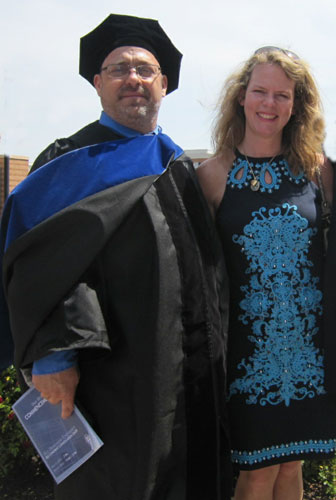 Mike Spata, in cap and gown, stands with his wife, Sarah, after the commencement ceremony on May 5. Spata was hooded at the graduation ceremony by Geoffrey Krafft, his advisor and director of JLab's Center for Advanced Studies of Accelerators.
Scrapbook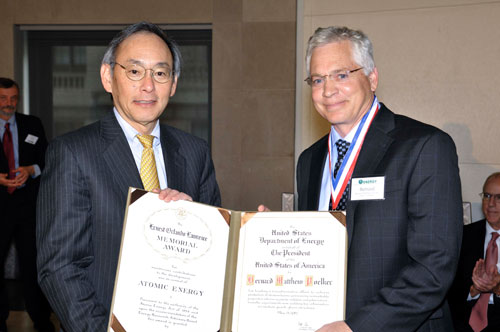 Injector Scientist Receives National Award
Matt Poelker, head of JLab's Center for Injectors and Sources, was one of nine winners of a 2011 Ernest Orlando Lawrence Award, recognized at a ceremony on May 21. The Lawrence Award is a national-level award from the Department of Energy that recognizes scientists for their leadership role in research and development in support of the Department of Energy and its missions. Here Poelker receives the award certificate from Energy Secretary Steven Chu. Photo: Charles Watkins, DOE
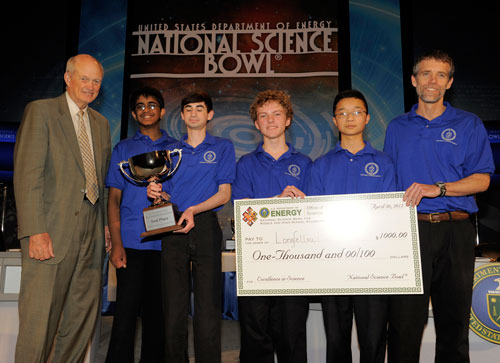 Virginia Middle School Champs Take 2nd at Science Bowl Nationals
Longfellow Middle School, from Falls Church, and winner of the Virginia Regional Middle School Science Bowl held at Jefferson Lab in March took second place at the Department of Energy's National Science Bowl. The national competition was held in Washington, D.C., at the end of April. Pictured is the Longfellow team with Coach Jim Bradford accepting a trophy and $1,000 prize for their school from William Brinkman, director of DOE's Office of Science. Photo: Dennis Brack, DOE
|
|
The On Target newsletter is published monthly by the Thomas Jefferson National Accelerator Facility (Jefferson Lab), a nuclear physics research laboratory in Newport News, Virginia, operated by Jefferson Science Associates, LLC, for the U.S. Department of Energy's Office of Science. Possible news items and ideas for future stories may be emailed to jlabinfo@jlab.org, or sent to the Jefferson Lab Public Affairs Office, Suite 15, 12000 Jefferson Avenue, Newport News, VA 23606
|


 Studying the strange side of nuclear physics has reaped Biplab Dey a rich reward: Dey was recently named the winner of the 2011 JSA Thesis Prize......
Studying the strange side of nuclear physics has reaped Biplab Dey a rich reward: Dey was recently named the winner of the 2011 JSA Thesis Prize...... It's no cliché to say that Chen Xu has science in his blood. His grandfather was an electrical engineer, his grandmother a cardiologist, his father is an irrigation scientist and his mother is a chemistry teacher.......
It's no cliché to say that Chen Xu has science in his blood. His grandfather was an electrical engineer, his grandmother a cardiologist, his father is an irrigation scientist and his mother is a chemistry teacher....... An estimated crowd of 8,000 people attended Jefferson Lab's Open House on May 19, taking advantage of a unique opportunity to tour the lab's facilities and learn about the research underway at the lab......
An estimated crowd of 8,000 people attended Jefferson Lab's Open House on May 19, taking advantage of a unique opportunity to tour the lab's facilities and learn about the research underway at the lab......